A journey through Alaska’s breathtaking landscapes
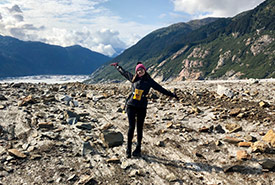
Justine standing on the rocky side of Meade Glacier (Photo courtesy of Justine Coutu)
Right after the end of my communications internship at the Nature Conservancy of Canada (NCC), I had the pleasure of embarking on a 12-day journey through Alaska. We travelled by land and sea, everyday discovering more and more of the state’s natural treasures, fascinating culture and welcoming people.
Although I’ve travelled quite a bit in the past, this was my first time visiting such a remote part of the world. It was a truly fascinating experience, and a great way to dive into nature after having written about it throughout the summer!
An impressive glacial landscape
When hearing about Alaska, we undoubtedly think of glaciers, huge ice formations that progressively cut through mountains and that create impressive valleys over millennia. During my trip, I was lucky enough to see two glaciers from three different vantage points: by sea, air and land.
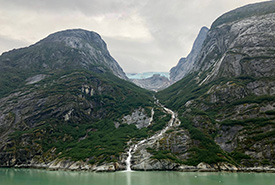
The Northern Sawyer Glacier, visible between mountains (Photo by Justine Coutu)
While sailing through the Inside Passage, we first encountered the Southern Sawyer Glacier, located at the end of the Tracy Arm fjord. Framed by 2,000-metre-high snow-capped mountains, it was a beautiful sight. For safety reasons, we had to stay about 300 metres away from the actual glacier front. Since there is no way to predict when an ice block will fall, keeping that distance is necessary, but in no way prevents you from seeing the glacier’s details with a pair of binoculars.
Related blog posts
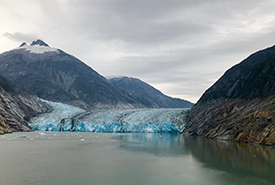
Glacial front of the Southern Sawyer Glacier (Photo by Justine Coutu)
We reached Sawyer Glacier at around 6 a.m. on a cloudy day, meaning that temperatures were close to 0 C and dropping as we approached the glacial front. Still, the biologist we were travelling with insisted that it was a beautiful day — and he was right! The fjord’s water was a vibrant shade of green and the glacier was the bluest ice I have ever seen. At one point, a block of ice detached and fell into the water. I was surprised by how loud this process was; it was a bit like firecrackers going off at a very fast pace.
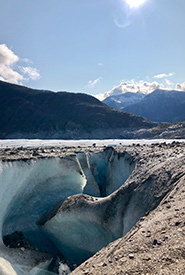
A glacier mill found on Meade Glacier (Photo by Justine Coutu)
A few days later, we arrived in Skagway, the northernmost city within the Inside Passage. After two days of heavy rain, the sun peeked through, and it was time to jump on a helicopter toward Meade Glacier. Our pilot took us over mountains, a variety of rivers and lakes (including one shaped like a heart!), a few other glaciers and — you guessed it — more mountains, before we reached our final destination.
Equipped with hiking gear and cameras, we hiked the glacier for about two hours with a wonderful guide who gave us insight into glacier formation, glacier structure and some fun facts about this particular glacier. Meade Glacier is unique because it is made of ice coming from two distinct areas of the Juneau Icefield. This is interesting because you can actually see it: while one side of the glacier is extremely rocky and covered in brown sediment, the other is pristine ice and white snow.
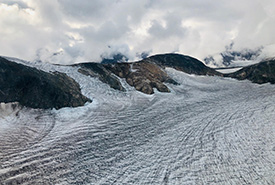
Part of the Juneau Icefield, viewed from above (Photo by Justine Coutu)
My favourite moments from this hike included drinking pure (and freezing cold) glacier water from a stream and walking along a glacier mill, which allows surface water to enter the glacier and facilitate the glacier's movement. The water flows into the mill at an impressive rate. If you stand close enough, you can feel the ice vibrating below your feet. Standing on a glacier makes you realize how powerful and, in some ways, how alive they are.
The Tongass National Forest
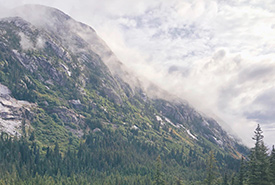
Mountains and forest surrounding the Whitepass and Yukon route (Photo by Justine Coutu)
Most of the hiking trails we explored are part of the Tongass National Forest, the largest national forest in the U.S. and currently the Earth’s largest remaining temperate rainforest, encompassing over 6.4 million hectares (16 million acres). Many of the hiking trails here allow visitors to walk deep into the forest and discover its wide variety of species.
Late August is the perfect time to encounter numerous species of salmon crowding the rivers; the salmon come here to die off naturally after spawning season. While we did see thousands of salmon, we, luckily, did not come across any black bears, which usually feast on the salmon. We also were lucky enough to see some bald eagles flying to and from their nests on the forest’s many cliffs.
While walking through the Tongass, it is hard not to notice Alaska’s official state tree: Sitka spruce. Towering almost 100 metres above the ground, this is the third-tallest conifer species in the world. Its needles are fragrant and often used in various home remedies, such as mosquito repellent, or boiled to make syrup and beer.
Exploring life in Alaska
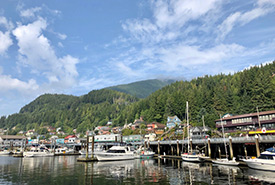
Ketchikan Harbour (Photo by Justine Coutu)
Whether it is walking through its rich forests, observing its many species or exploring its colossal glaciers, Alaska and its landscapes are definitely worth seeing. Although this alone is enough to justify the 6,000-kilometre-journey from Montreal to the Last Frontier, visiting Alaska is also about understanding its history and meeting its people. Throughout this trip, I learned about the Klondike Gold Rush aboard the Whitepass and Yukon Railroad train, discovered ancient totems in the town of Ketchikan and met members of Indigenous communities close to Skagway. I ate fresh Alaskan king crab almost every day, had a drink at the iconic Red Dog Saloon in Juneau and learned to carve wood with local artists.
Needless to say, this was the trip of a lifetime. If you love nature and aren’t afraid of cold temperatures or a bit of rain, Alaska should definitely be next on your list!
The Conservation Internship Program is funded in part by the Government of Canada's Summer Work Experience program.


